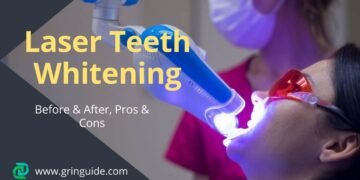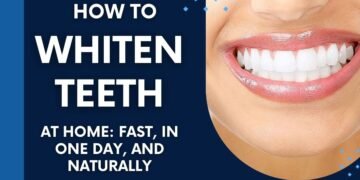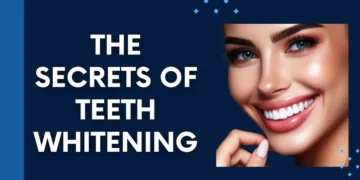Table of Contents
Introduction
The pursuit of a brighter, whiter smile is a common aspiration for many individuals. Over time, teeth can become discolored due to various factors such as aging, consumption of staining foods and beverages, and habits like smoking.
To address this, numerous treatments are available, primarily categorized as teeth whitening and bleaching. While these terms are often used interchangeably, they represent distinct processes with unique benefits and considerations.
Teeth whitening generally refers to restoring the natural color of teeth by removing surface stains and discolorations. This process often involves the use of non-bleaching agents, such as toothpaste or over-the-counter products designed to clean and polish the teeth.
On the other hand, bleaching goes a step further by altering the color of the teeth beyond their natural shade. This is achieved using bleaching agents like hydrogen peroxide or carbamide peroxide, which penetrate the enamel to break down stains at a molecular level.
The desire for whiter teeth has led to a proliferation of both professional and at-home treatments, each with their respective advantages and limitations. Understanding the differences between teeth whitening and bleaching is crucial for individuals seeking to enhance their smiles.
This blog post aims to provide a comprehensive overview of these treatments, detailing their processes, effectiveness, and potential risks. By the end, readers will be better equipped to make informed decisions about which option best suits their needs.
Understanding Teeth Whitening
Teeth whitening refers to a set of procedures aimed at removing surface stains from teeth and restoring their natural color.
The primary goal of teeth whitening is to address discoloration that accumulates over time due to various factors: Foods, beverages, and lifestyle choices such as smoking are common culprits behind these stains.
For instance, coffee, tea, red wine, and certain fruits can leave pigments on the enamel, leading to a yellowish or brownish tint. Smoking introduces nicotine and tar, which are particularly notorious for staining teeth.
There are several methods available to achieve whitening, each varying in effectiveness and convenience. Over-the-counter products are popular for their accessibility and ease of use.
- Whitening toothpaste is a common choice; it contains mild abrasives and chemicals like hydrogen peroxide or carbamide peroxide that help break down stains.
- Whitening strips, another favored option, are thin, flexible pieces coated with a peroxide-based gel. These strips adhere to the teeth and are typically worn for a specified period, usually daily over a couple of weeks, to achieve noticeable results.

For those preferring home remedies, baking soda is often recommended due to its mild abrasive properties. When mixed with water or lemon juice, baking soda can form a paste that is gently brushed onto the teeth to help lift surface stains. However, while home remedies can offer some degree of whitening, they are generally less effective compared to commercial whitening products.

It is important to note that teeth whitening is most effective on extrinsic stains—those on the outer surface of the teeth.
Intrinsic stains, which are deeper and often caused by factors such as certain medications or trauma to the teeth, may not respond well to these methods. Therefore, understanding the type of discoloration one has can help in selecting the most appropriate whitening treatment.
Understanding Teeth Bleaching
Teeth bleaching is a cosmetic dental procedure aimed at altering the natural color of the teeth, often resulting in a shade lighter than the original.

Unlike teeth whitening, which primarily restores teeth to their natural color by removing surface stains, bleaching penetrates deeper to achieve a more dramatic change in tooth color.
This advanced treatment is particularly effective for individuals seeking to attain a brighter and whiter smile beyond their natural tooth shade.
The primary agents used in teeth bleaching treatments are hydrogen peroxide and carbamide peroxide. These chemicals are potent oxidizing agents that break down into oxygen molecules upon application.
The oxygen molecules then penetrate the enamel and dentin layers of the teeth, reacting with the discolored molecules trapped within. This reaction breaks the bonds of the stains, effectively reducing their visibility and altering the overall color of the teeth.
Hydrogen peroxide is typically found in concentrations ranging from 3% to 35%, depending on whether the treatment is conducted at home or professionally in a dental office. Professional treatments often use higher concentrations for quicker and more noticeable results.
Carbamide peroxide, on the other hand, breaks down into hydrogen peroxide and urea, providing a slower and more sustained release of the active agent. This makes it a popular choice for at-home bleaching kits, as it minimizes the risk of sensitivity and irritation.
The chemical processes involved in teeth bleaching target both intrinsic and extrinsic stains.
- Intrinsic stains are those that have penetrated the deeper layers of the teeth, often caused by aging, medication, or trauma.
- Extrinsic stains, on the other hand, are surface-level discolorations resulting from food, beverages, and smoking.
By breaking down these stains at a molecular level, bleaching treatments can significantly enhance the brightness and whiteness of the teeth, offering a long-lasting and effective solution for a more radiant smile.
Comparing Whitening and Bleaching
When it comes to achieving a brighter smile, understanding the differences between teeth whitening and bleaching is crucial. The primary distinction lies in their respective strengths and effectiveness.
1. After-Effects
The increased potency of bleaching agents often comes with a higher risk of after-effects. Tooth and gum sensitivity are common side effects, particularly after professional bleaching treatments.
Whitening products, being gentler, tend to cause less discomfort, making them a more suitable option for individuals with sensitive teeth. Nonetheless, it is essential to follow the recommended usage guidelines for both methods to minimize potential adverse effects.
2. Depth of whiteness achieved
The depth of whiteness achieved also varies between the two methods. Whitening can effectively remove surface stains and brighten teeth by a few shades, making it an excellent option for those with mild discoloration.
Bleaching, on the other hand, can produce more significant changes, often lightening teeth by several shades. This makes bleaching a preferred choice for individuals seeking more noticeable and long-lasting results.
3. Frequency of treatments required
Another critical factor to consider is the frequency of treatments required to maintain the desired level of whiteness.
- Whitening treatments may need to be repeated more regularly, often every few months, to sustain their effects.
- Bleaching treatments, given their higher potency, can provide longer-lasting results, reducing the need for frequent touch-ups.
4. Frequency of treatments
Cost is another aspect where differences become apparent.
- Whitening treatments, particularly over-the-counter products, are generally more affordable and accessible.
- Professional bleaching services, while more expensive, offer a higher degree of effectiveness and customization. Ultimately, the choice
Teeth whitening offers a myriad of benefits, making it a popular choice for those looking to enhance their smile. One of the primary advantages is its effectiveness in removing surface stains caused by daily consumption of staining substances like coffee, tea, and red wine.
This treatment is generally more affordable than other dental procedures, making it accessible to a broader audience. Additionally, over-the-counter whitening products provide convenience, allowing individuals to perform the treatment in the comfort of their own homes.
However, teeth whitening does come with its set of limitations and potential risks. A significant drawback is the temporary sensitivity that many individuals experience post-treatment.
This heightened sensitivity can make consuming hot or cold foods and beverages uncomfortable for a short period. Moreover, the results of teeth whitening are not permanent, necessitating repeated treatments to maintain the desired shade. This can be both time-consuming and costly in the long run.
To prolong the effects of teeth whitening, certain preventive measures can be adopted:
- Avoiding staining foods and beverages is crucial; reducing the intake of coffee, tea, red wine, and dark berries can significantly extend the duration of the whitening results.
- Using a straw when drinking beverages that can stain your teeth can also minimize contact with the enamel.
- Additionally, incorporating whitening toothpaste into your daily oral hygiene routine can help maintain the brightness of your smile.
- Regular brushing, flossing, and dental check-ups are fundamental practices that support overall oral health and the longevity of whitening results.
Pros and Cons of Teeth Whitening
Teeth whitening has become a popular choice for individuals seeking a brighter smile due to its non-invasive nature and accessibility. One of the primary benefits of teeth whitening is that it can significantly enhance the appearance of one’s teeth without requiring any surgical procedures.
This treatment is widely available, with options ranging from professional in-office treatments to over-the-counter products, making it accessible to a broad audience.
Another advantage of teeth whitening is the immediate improvement in self-confidence it can provide. A whiter smile can enhance one’s overall appearance, leading to increased self-esteem and a more positive self-image.
In many cases, the results are noticeable right after the first treatment session, which can be highly rewarding for the individual.
Despite these benefits, there are some limitations and potential risks associated with teeth whitening. One of the primary concerns is the possibility of uneven results. Depending on the initial condition of the teeth, some areas may whiten more effectively than others, leading to an inconsistent appearance.
Additionally, temporary tooth sensitivity is a common side effect, particularly with stronger whitening agents. This sensitivity usually subsides after a few days, but it can be uncomfortable for some individuals.
To maintain the results of teeth whitening and minimize potential side effects, it is essential to follow specific guidelines.
- Avoiding foods and beverages that can stain the teeth, such as coffee, tea, and red wine, can help prolong the effects of whitening.
- Additionally, practicing good oral hygiene, including regular brushing and flossing, is crucial in maintaining a bright smile.
- Using toothpaste specifically designed for whitened teeth can also help preserve the results.
- Lastly, regular dental check-ups are essential to monitor the condition of the teeth and address any issues promptly.
Pros and Cons of Teeth Bleaching
Teeth bleaching is a popular cosmetic dental procedure known for its ability to address deeper stains and achieve a more dramatic change in tooth color. Unlike standard whitening treatments that primarily remove surface stains, bleaching penetrates the enamel to break down discoloration within the tooth structure.
This makes it particularly effective for individuals with significant staining from factors like tobacco use, certain medications, and long-term consumption of staining beverages like coffee and red wine.
One of the primary advantages of teeth bleaching is its efficacy. Professional bleaching treatments can lighten teeth by several shades in a relatively short amount of time. This level of effectiveness can lead to a more noticeable and satisfying result for patients seeking a bright, white smile.
However, teeth bleaching is not without its drawbacks. One of the most common side effects is increased tooth sensitivity. This occurs because the bleaching agents can temporarily weaken the enamel, making teeth more susceptible to temperature changes and certain foods.
Additionally, some individuals may experience gum irritation, particularly if the bleaching agent comes into contact with the soft tissues of the mouth. This underscores the importance of professional supervision when undergoing bleaching treatments.
To minimize risks, it is crucial to choose a safe bleaching treatment and follow the product instructions meticulously. Professional dental supervision ensures that the bleaching agent is applied correctly and that the patient’s oral health is monitored throughout the process.
Over-the-counter bleaching products can be effective, but they often carry a higher risk of misuse and potential side effects without professional guidance.
Ultimately, while teeth bleaching offers significant advantages in terms of whitening efficacy, it is essential to weigh these benefits against the potential risks. Consulting with a dental professional can help individuals make an informed decision and achieve the best possible results with minimal adverse effects.
Making an Informed Decision
Deciding between teeth whitening and bleaching treatments requires careful consideration of several factors, including the extent of staining, budget, and sensitivity concerns. Understanding these elements can help you make an informed choice that aligns with your individual needs and goals.
The extent of staining
The extent of staining is a primary factor to consider. Surface stains, often caused by foods, beverages, and tobacco, may be effectively addressed through teeth whitening treatments. These treatments typically use milder agents to lighten the teeth’s surface, making them suitable for minor discoloration.
However, intrinsic stains, which are deeper and often caused by medications or trauma, may require bleaching. Bleaching treatments utilize stronger agents like hydrogen peroxide to penetrate the enamel and remove deeper stains, offering more significant results.
Budget
Budget constraints also play a crucial role in the decision-making process.
Teeth whitening treatments, such as over-the-counter products and in-office procedures, generally vary in cost. Over-the-counter options tend to be more affordable but may provide less dramatic results. Professional whitening performed by a dentist can be more costly but often delivers more noticeable outcomes.
Conversely, bleaching treatments, especially those administered by dental professionals, can be more expensive due to their potency and the need for a controlled environment.
Sensitivity
Sensitivity concerns cannot be overlooked when choosing between whitening and bleaching. Individuals with sensitive teeth may find whitening treatments more tolerable, as they use gentler agents.
Bleaching, while more effective for stubborn stains, can increase tooth sensitivity due to its stronger chemical composition. It is essential to weigh the benefits against the potential discomfort, particularly if you have a history of dental sensitivity.
Ultimately, consulting with a dental professional is crucial to determine the most suitable and safe treatment option for your specific situation. A dentist can assess the degree of staining, discuss your budget, and evaluate any sensitivity issues, guiding you towards the best choice.
By considering these factors and seeking professional advice, you can achieve a brighter, healthier smile that meets your expectations and needs.
Conclusion
In understanding the differences between teeth whitening and bleaching treatments, it is evident that both methods offer unique benefits tailored to varying needs. Teeth whitening typically involves the removal of surface stains caused by food, beverages, and lifestyle habits, utilizing products readily available over-the-counter or through professional services. This approach is generally suited for individuals seeking to enhance their natural tooth color and maintain overall oral health.
On the other hand, teeth bleaching employs stronger agents, such as hydrogen peroxide or carbamide peroxide, to significantly lighten the color of the teeth by penetrating below the surface and altering the intrinsic color. This treatment is ideal for those dealing with more persistent discoloration or seeking a more dramatic change in their smile’s appearance.
Choosing between teeth whitening and bleaching ultimately depends on personal preferences, the extent of discoloration, and the desired outcome. It is crucial to consider professional advice from a dental care provider to determine the most appropriate treatment based on individual oral health conditions. Consulting with a dentist can also ensure that the chosen method is safe and effective, reducing the risk of potential side effects.
Prioritizing oral health is paramount, and making informed decisions about teeth whitening or bleaching can contribute to achieving a brighter, healthier smile. Whether opting for whitening to maintain natural tooth color or bleaching for a more profound transformation, the key lies in understanding the differences and seeking professional guidance. By doing so, individuals can achieve their desired results while ensuring the well-being of their teeth and gums.
FAQs
-
Is Teeth Whitening Safe?
Yes, when performed correctly, teeth whitening is safe.
-
Does Teeth Whitening Cause Sensitivity?
Some people may experience temporary sensitivity during or after teeth whitening treatments
-
How Long Does Teeth Whitening Last?
The effects of teeth whitening can last from a few months to up to three years, but this varies from person to person.
-
Can I Whiten Crowns or Fillings?
Unfortunately, Whitening treatments do not affect the color of crowns, fillings, or veneers.
-
How Many Shades Can I Expect to Whiten?
Results can vary widely, but many people can achieve a change of two to seven shades.
-
Does Teeth Whitening Hurt?
Teeth whitening should not hurt. when performed correctly you should not feel any pain.









